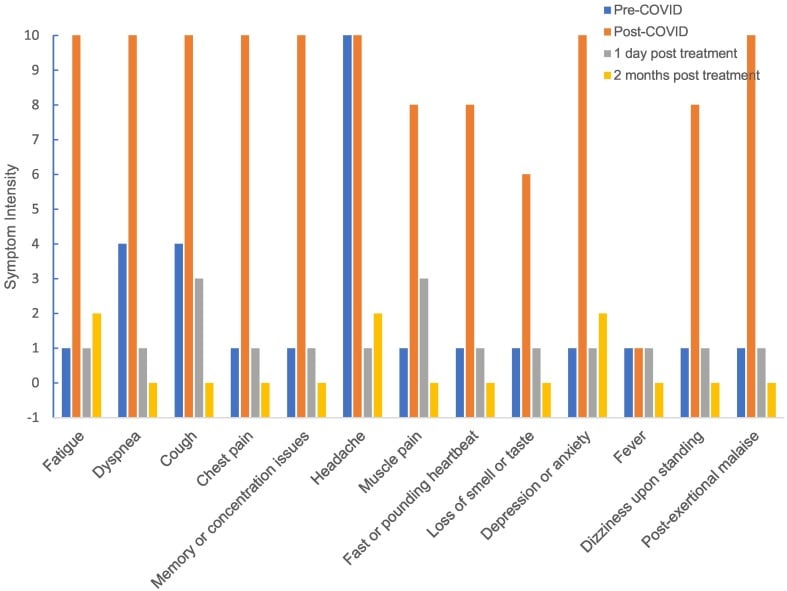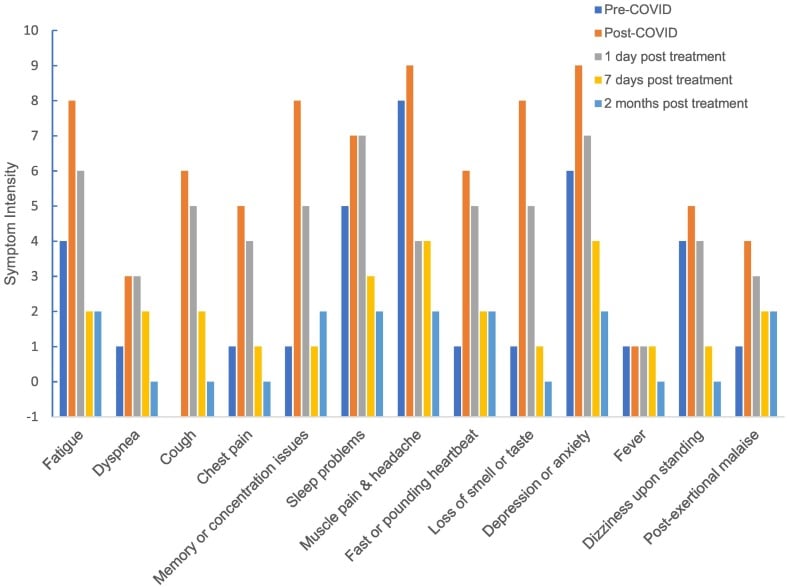Case Study: Can the Stellate Ganglion Block (SGB) Reduce Symptoms of Long COVID?

Since March 2020, there have been 442 million COVID-19 cases worldwide. Over the last two years, we've learned a lot about how the virus works and how to protect ourselves against it. We're also learning what COVID-19's long-term impact on our mental and physical health will be.
While most people who are infected with COVID-19 recover from their symptoms in within four weeks, studies indicate that about 10% of people experience long COVID symptoms.1 Long COVID can present itself in many ways but the most common symptoms are:2
- Fatigue
- Dizziness upon standing
- Elevated resting heart rate
- Shortness of breath
- Brain fog
- Sleep disturbance
- Fevers
- Gastrointestinal symptoms (e.g., nausea, vomiting, diarrhea, cramping, etc.)
- Loss of smell
- Loss of taste
- Anxiety
- Depression
Research on Long Covid
Medical professionals continue to innovate as we learn more about how COVID-19 can impact the body in the long term. While early papers, case studies, and trials have provided helpful information about Long COVID, more research needs to be conducted.
Stella Certified Doctor Dr. Luke D. Liu and Research Coordinator Deborah L. Duricka recently added to this body of knowledge with their independent study conducted earlier this year, Stellate ganglion block reduces symptoms of Long COVID: A case series. This study explains how the Stellate Ganglion Block (SGB) successfully reduced two individuals' long COVID symptoms.
Stellate Ganglion Block's (SGB) History and How It's Used Today
is an injection of local anesthetic into the stellate ganglion – a bundle of nerves in the neck – first performed in 1926 to treat chronic back pain. Almost 100 years later, is still a common pain management procedure.
In 2006, Stella's Chief Medical Officer Dr. Eugene G. Lipov pioneered the use of to alleviate symptoms of Post Traumatic Stress Disorder (PTSD) – please note that Stella prefers the term Post Traumatic Stress Injury (PTSI). Two years later, a peer-reviewed study on the topic was published.
Dr. Liu's study offers another possible application of : the treatment of long COVID symptoms.
as a Long COVID Treatment
People with long COVID may develop dysautonomia, or the dysfunction of the parasympathetic nervous system. The parasympathetic nervous system regulates non-voluntary body functions like digestion, blood pressure, sweating, and more. Many with long Covid present with some these symptoms.
During , local anesthetic is injected which temporarily blocks or "turns off" the nerves it's injected into which can help restore normal biological functions.
Dr. Liu performed on two women with long COVID symptoms. After the procedure, both women reported improvement, suggesting that may be able to effectively treat long Covid symptoms.
Reviewing the Case Study
Eight months after the onset of the COVID-19 diagnosis, the 42-year-old woman was still experiencing over 7 different long COVID symptoms:
- Debilitating fatigue
- Mental fogginess
- Difficulty concentrating
- Elevated resting heart rate
- Sleep disturbance
- Altered sense of taste and smell
- Lack of appetite and food aversion due to changes in taste and smell
The unpalatability of food led to a 30-pound weight loss that continued to progress. On top of her symptoms, she had been let go from her job and was teaching four-hour CPR courses with difficulty, relying on her teaching manual to recall facts and procedures previously well known to her.
After receiving on her right side, she had immediate improvement in taste and smell as well as improvement in mental clarity and concentration. Two days later, she received on her left side and immediately experienced more improvement to their taste and smell.
Soon after, she was able to drive home without conscious effort to recall the route, demonstrating noticeable improvement in memory. On top of that, she was able to teach a nine-hour course for CPR instructors without relying on written material, demonstrating a drastic improvement in recall.
Two weeks later, she reported durable restoration of taste and smell and refreshing sleep resembling her pre-COVID-19 baseline.
COVID Symptoms Before and After Treatment
Seven months after her COVID-19 diagnosis, the 44-year-old woman entered Dr. Liu's office.
Initially, her COVID-19 symptoms were loss of smell and taste, mental fogginess, headache, and shortness of breath.
One week after the onset of acute symptoms, her headache worsened, prompting evaluation in the ER. Her headache symptoms dissipated over the following two weeks but she still experienced a multitude of symptoms:
- Declining cognitive function
- Developement of stuttering speech
- Significant cognitive impairment
- Right-sided paresis (muscular weakness)
Her symptom of paresis prompting hospitalization and evaluation. Her MRI results demonstrated inflammation and did not show signs of neither a stroke nor viral infection of the brain.
After being discharge with 'sequelae of COVID-19-induced ventriculitis' as a leading consideration, she was prescribed intense occupational, physical, and speech therapy for profound memory deficits, speech impediment, impaired coordination, inability to concentrate, and debilitating fatigue. Yet, despite these therapies, she could not continue her work as a special education teacher.
Now seven months later, she had returned to work with limited duties and shortened hours with while still experiencing Long COVID symptoms:
- Debilitating fatigue and speech impediment.
- Altered taste that led to food aversion and significant unintentional weight loss.
- Severe generalized body pain described as dull with pins and needles that occasionally kept her bedbound.
- The acute stress and mental or physical exertion exacerbated her right-sided motor deficits, fatigue, and cognitive issues.
- Intermittent headaches described as "crawling pain in my brain."
Within minutes of receiving treatment on her right and left side, her taste and smell drastically improved. Three days later, her physical and mental stamina had improved significantly, allowing her to perform routine household activities without debilitating lapses in memory.
One week after treatment, she began a new job as a high-school teacher and was able to teach a full day of classes, which she states would have been impossible prior to treatment. Two weeks later, she reported durable resolution of stuttering and 75% improvement in all other symptoms.
At 60-day follow-up, she reported normal levels of fatigue and cognitive function, durable restoration of smell and taste, and absence of post-exertional malaise.
COVID Symptoms Before and After Treatment

As the COVID-19 pandemic continued to impact the world, an increasing number of people began to experience long-term symptoms that go beyond the initial phase of the illness. While vaccines, boosters, and medications like Paxlovid became standard treatments for combating the virus, effective solutions for the debilitating symptoms of long Covid remained limited. However, in December 2021, Dr. Liu, a Stella-certified provider, reported positive outcomes in two long Covid patients through the use of Stellate Ganglion Block (SGB). This development highlights the potential of Stella's advanced Stellate Ganglion Block, known as the Dual Sympathetic Reset, in addressing and alleviating long COVID symptoms.
A Promising Future
While this has not been through any clinical studies and the only data are investigative case studies at this point, its application in treating long COVID/PASC is novel but promising.
The lack of effective treatments for long COVID/PASC makes the an attractive therapeutic modality that deserves further investigation.
Stella is a leader in treating emotional trauma, mental health challenges, and long COVID symptoms with innovative treatments like the Dual Sympathetic Reset (DSR), an advanced Stellate Ganglion Block (SGB). If you want to find out more information about treating long COVID symptoms with DSR SGB, please speak to our care advocate by calling 908-293-7559.
1. https://health.ucdavis.edu/coronavirus/covid-19-information/covid-19-long-haulers#:~:text=This%20condition%20can%20affect%20anyone,will%20experience%20long%2Dhaul%20symptoms.
2. Soriano J.B., Allan M., Alsokhn C., Alwan N.A., Askie L., Davis H.E., Diaz J.V., Dua T., de Groote W., Jakob R., Lado M., Marshall J., Murthy S., Preller J., Relan P., Schiess N., Seahwag A. World Health Organization; 6 October 2021. A Clinical Case Definition of Post COVID-19 Condition by a Delphi Consensus.
